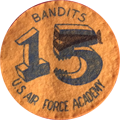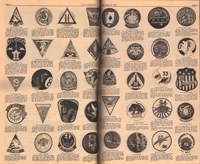1. Terms:
Design: A unit's proposed sketch for an emblem.
Emblem: The officially approved colored artwork for a unit.
Patch: a uniform item created from the emblem.
2. The “Description” and “Significance” narratives on the individual history pages are taken directly from the Wing Heritage Committee documents, lightly edited for accuracy or style.
3. The “History” is based on a combination of the Wing Heritage Committee narrative and original research.
4. Based on documentation that initiated the creation process in the fall of 1961, it is assumed the first year a patch was used (for Squadrons 1-24) was 1962, unless documentation or personal recollection fixes a different date.
5. For Squadrons 25-40, the date of first use of a squadron patch is assumed to be the year after squadron activation, which allowed for the creative and approval process to run its course, and coincides with its first appearance in Polaris.
6. The primary reference for patch timeline usage is the Polaris yearbook. Starting with the 1965 edition, patches are usually displayed with the squadron or graduate entries, generally fixing their usage in time.
This icon indicates the year(s) a particular patch appears in Polaris.

7. Personal Recollections between 1990-2002 were culled from the archives of Special Collections. Recollections from 2019 and later were the result of direct appeals via telephone, email, or U.S. Mail.
8. On the individual history pages, clicking on most of the patches opens a full-sized graphic in another window.


































































